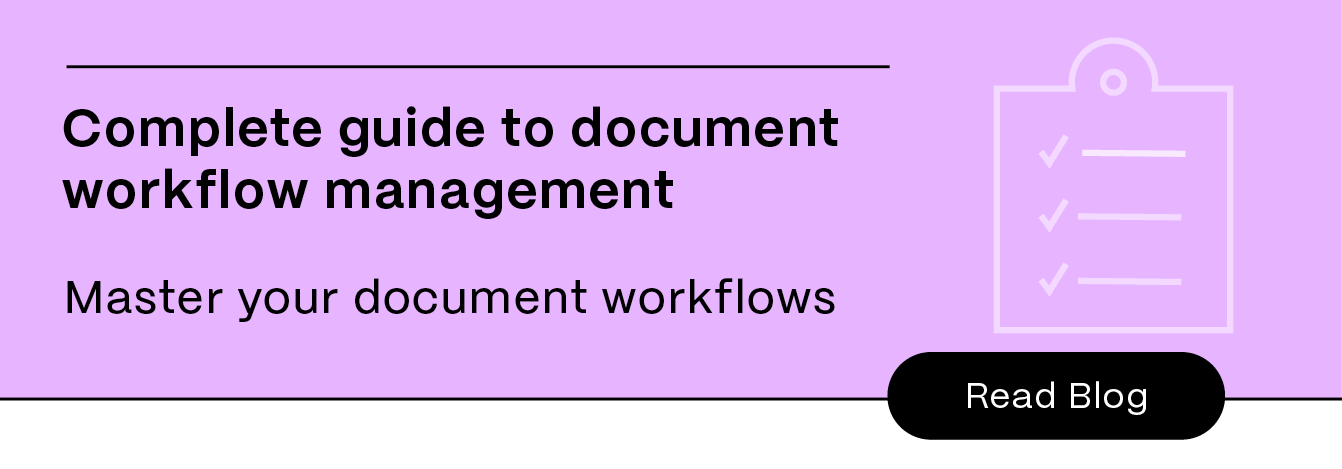
Blog
Sales workflow process: benefits, automation and stages

Sales departments are critical for bringing in new business and ultimately keeping the lights on. That’s why the workflows your department uses are so important. With a streamlined process that effectively guides leads through the sales funnel, reps can get more out of their efforts and increase your company’s profitability.
In this guide, we focus on the sales workflow process: what it is, why it matters, what it typically looks like, and how you can elevate processes further with automation.
TL;DR
- A sales workflow is a standardized set of steps that reps follow to engage leads and secure customers.
- Benefits of a sales workflow include increased revenue, better employee experience, and improved forecasting.
- A typical sales process consists of 9 stages: research, prospecting, lead qualification, outreach, demonstration, responding to objections, proposal, closing the deal, and nurturing customers.
- Sales process workflow automation saves time and boosts revenue.
What is a sales workflow?
A sales workflow is a standardized set of steps that sales professionals follow to engage leads and secure customers. It outlines the most efficient processes for identifying prospects and turning them into buyers. With a clear plan to follow, it’s easier for sales reps to stay on top of a high volume of leads and consistently garner new business.
Every organization has different sales workflows depending on their products, customers, and business sector. It takes research and deep industry knowledge to build a sales funnel workflow that works for you.
Benefits of a sales workflow process
A well-defined sales workflow guides sales reps on how to engage with prospects at every stage of the buying funnel. While closing a sale involves skills that are hard to standardize, having a clear workflow establishes best practices, reduces human error, and improves performance tracking. Here are some key benefits of using a sales workflow.
Increased revenue
Being able to anticipate a prospect’s needs — and address those needs early on in the sales process — increases the likelihood of closing deals and boosting revenue.
Building a standardized sales process makes it easier to track when and why a lead takes action. With this insight, your sales reps can accurately identify and focus on high-potential leads that are more likely to convert. Teams can use these findings to make process improvements and optimizations, helping you stand out from competitors and drive more business.
Better employee experience
A repeatable sales workflow improves the onboarding experience for new reps and boosts employee retention. This is important, as 76% of employees would stay at a company longer when provided with support and training needed to succeed.
A sales process workflow that supports new reps with lead nurturing and conversion boosts their confidence and speeds up skill development. As a result, employees are more likely to grow their careers within your organization, reducing the high costs of turnover.
Higher customer satisfaction
Since the early stages of the sales process feed directly into the customer journey, a workflow that creates positive experiences for leads also helps improve customer satisfaction. By promoting thoughtful and responsive communication, sales workflows ensure customers are satisfied from the start and stay eager for what’s next.
Improved forecasting
A standardized sales process makes it easy to track where prospects are in the sales pipeline, leading to more accurate financial forecasts. It provides data on how many customers to expect in the upcoming period, setting clear expectations for future revenue.
9 steps in a sales process workflow
We’ve covered the benefits of having a process for sales reps, but how do you create a sales workflow? Here are nine steps of a typical workflow you can modify to meet your business needs.
1. Research and preparation
Research your target audience, competitors, and current market to inform your sales strategy. Before engaging with leads, understand what sets your company apart from competitors. Then, identify the best ways to connect with leads at each stage of the sales funnel.
Consider the following questions to help with this step:
Are potential customers currently aware of the problem your services solve?
Sometimes, your target audience may not recognize their challenges or know that solutions are available. These potential leads are focused on maintaining the status quo, unaware that better options exist. When they aren’t actively searching for a solution, you’ll need to research and develop creative ways to get their attention.
What resources will leads be most interested in at each funnel stage?
Make sure you’re prepared with resources like blog articles, downloadable assets, and demonstrations appropriate for each funnel stage. For example, if you sell eco-friendly building materials, targets at the awareness stage will want an article about sustainable construction, not a chart comparing you to a competitor. That chart will be more valuable for prospects at the middle of the funnel who are already familiar with your company and want to learn more about what sets you apart.
What is your ideal customer profile (ICP)?
An ICP is a framework that defines the attributes of your most valuable customers. Identifying potential leads that meet ICP criteria helps you allocate resources more effectively with strategic targeting.
2. Prospecting
Using what you’ve prepared from the research phase, start sourcing early-stage leads through active outreach. Prospecting covers a range of activities that sales reps may carry out on a daily or weekly basis, such as:
- Cold calling
- Cold emailing
- Referral outreach
- Networking at in-person events
- Connecting via social media sites like LinkedIn
This is hardly an exhaustive list. You can develop a number of creative prospecting approaches based on what your business is selling and what resources are available to your team.
3. Lead qualification
To improve lead quality, you should have a process in place to determine which prospects have a higher likelihood of converting. This step should begin as soon as you identify a list of leads, and continue as an ongoing touchpoint throughout the sales funnel.
Lead qualification isn’t just used to determine which leads are more likely to become customers — it’s also used to remove unqualified leads from the sales cycle. By identifying these individuals early on, your team can focus more time and attention on sales-qualified prospects, boosting conversion rates and revenue.
4. Outreach
Reach out to high-quality leads and engage them with content, resources, and conversation. During this stage of a sales workflow, sales reps actively build relationships with high-intent prospects. This step can take place over email, phone calls, and at in-person meetings or client events.
5. Presentation or demonstration
If outreach is successful, set up a one-to-one demo. Walking leads through the features and benefits of what your company has to offer helps bring them closer to a decision.
A product presentation or demo will differ depending on what you sell. For a software company, it might mean a live walkthrough of solution capabilities. For a finance management firm, a sales rep could hold a meeting on how the firm would exceed a prospect’s financial goals, offering examples of how other clients have profited in the past.
The demo should help prospects understand your product or service so they can determine whether it’s the right fit. Focus on marketing your offerings and answering prospect questions.
6. Respond to objections
Prepare for how to respond to concerns from prospects that might stand in the way of a purchase. As leads become more knowledgeable about a product or service, they’re likely to raise questions around potential issues. Draw on your research to anticipate these and prepare proactive responses. Be sure to meet opposition with professional tact, empathizing with leads rather than dismissing their worries.
7. Quote or proposal
If a lead expresses interest in making a purchase, put together a price quote or a proposal that includes all details related to the transaction. A typical quote or proposal will include information on:
- Product features
- Pricing
- Delivery timeline
- Refund and warranty information
Businesses should have proposal documents templatized in order to efficiently tailor these to each prospect.
Related read: Unlock efficiency and streamline workflows with ShareFile templates
8. Close deal
When buyers reach a decision on how they’d like to proceed with a sale, the deal closes. Deals are either “closed lost” or “closed won.” Closed won is when the prospect decides to become a customer. If they formally decline to move forward with the next step of the sales process and leave the funnel, the deal is considered closed lost.
9. Nurture customers
To increase customer retention, provide ongoing value by looking for opportunities to optimize their experience with your company. There are several ways to nurture customers during and after a sale, including:
- Onboarding: Guide customers through their first few interactions with your product or service to help streamline implementation.
- Upselling: Suggest and introduce products that are more comprehensive or deluxe than what the customer currently has.
- Cross selling: Present add-on products or services that complement what the customer has already purchased.
- Customer support: Provide ongoing assistance for customers who have questions or need help with implementation.
- Sending resources: Offer marketing materials or useful guides that empower customers to get more out of your offerings.
- Contract renewals: Send reminders when it’s time to renew contracts so customers don’t forget.

Save time, boost revenue with sales workflow automation
Incorporating automation into your sales workflow increases efficiency, enables staff to close more deals, and drives up revenue. Not only does automation streamline workflows, it reduces human error and keeps more leads in the funnel. Sales processes that can be automated include:
- Lead capture: Automatically collect data on leads from multiple sources, like form fills and event registrations.
- Follow ups: Ensure that sales reps don’t forget to follow up with prospects by using automated reminders.
- Marketing emails: Execute more targeted email campaigns with automation tools that use customer data to instantly personalize messages.
- Meeting preparation: Take time back from tasks like sending meeting invites, logging RSVPs, and creating agendas for presentations or demos.
- Reporting and analytics: Enhance your sales workflow with automated insights.
Professionals can save around two or more hours every day by using automation within workflows. Beyond productivity, AI-driven automation can improve both the speed and quality of work. For example, 73% of salespeople who use AI automation tools say it improves conversation quality when they reach out to leads.
Related read: Transform your business with AI workflow automation
Optimize your sales workflow for success
A sales workflow helps sales reps follow best practices to engage prospects at every funnel stage, accelerating the decision to become a customer. Because a workflow lets salespeople anticipate prospects’ needs, it increases employee retention, customer satisfaction, and ultimately company revenue.
Once you’ve created a process that supports your sales goals, automate tedious tasks to increase efficiency and boost customer satisfaction. In today’s competitive sales landscape, technology is the key to taking your business further.

Related Resources

Blog